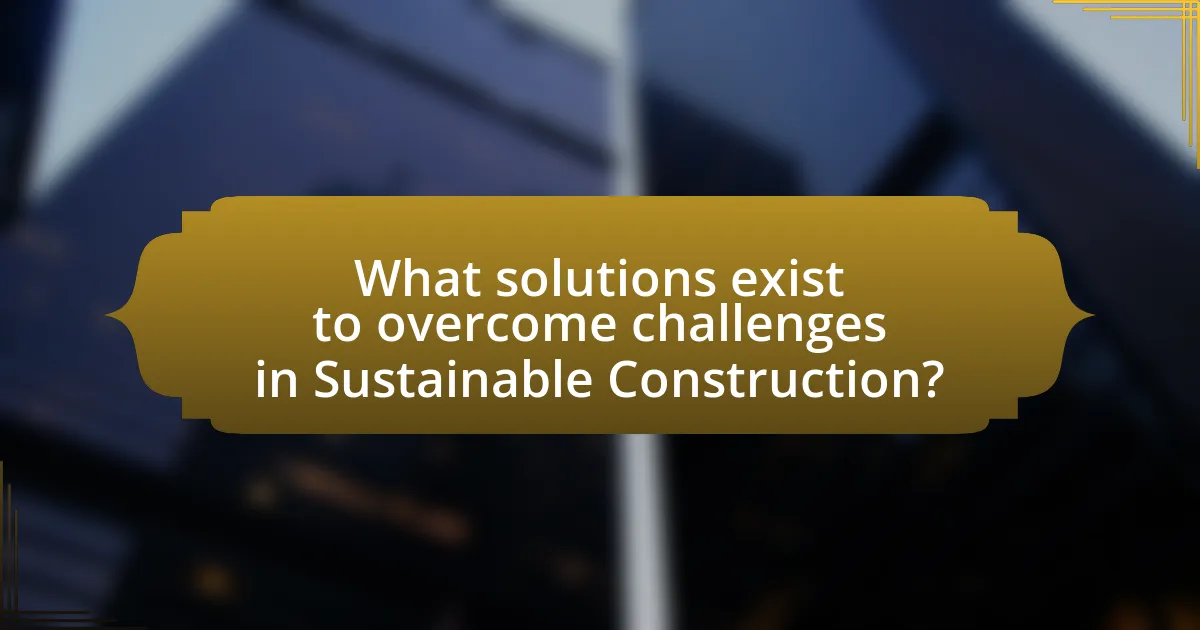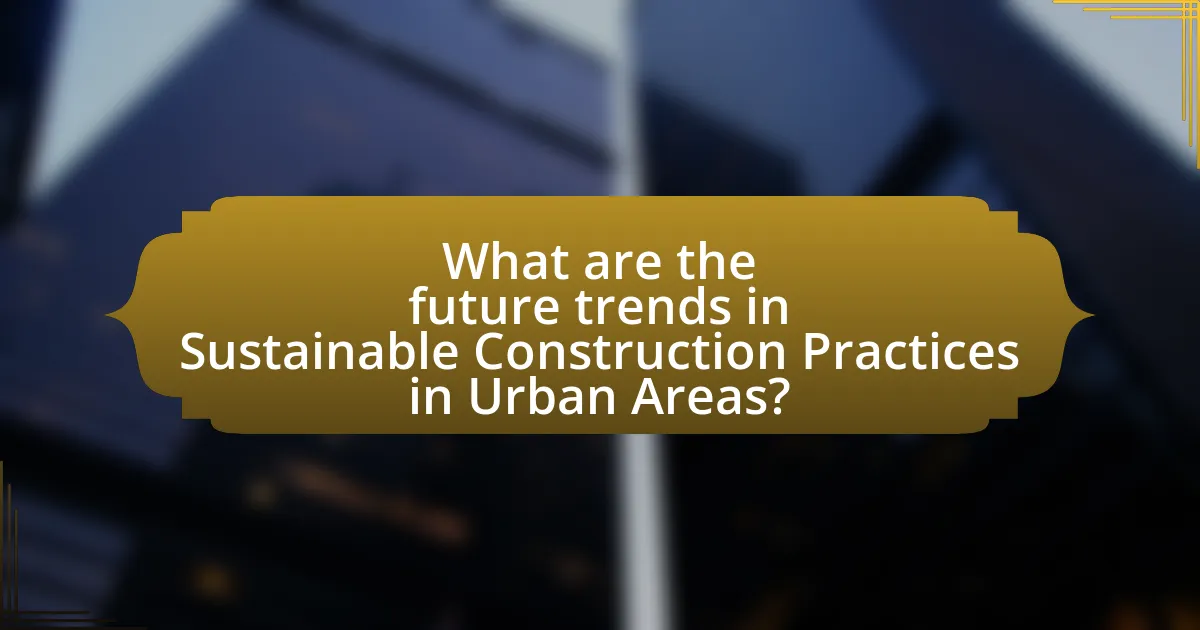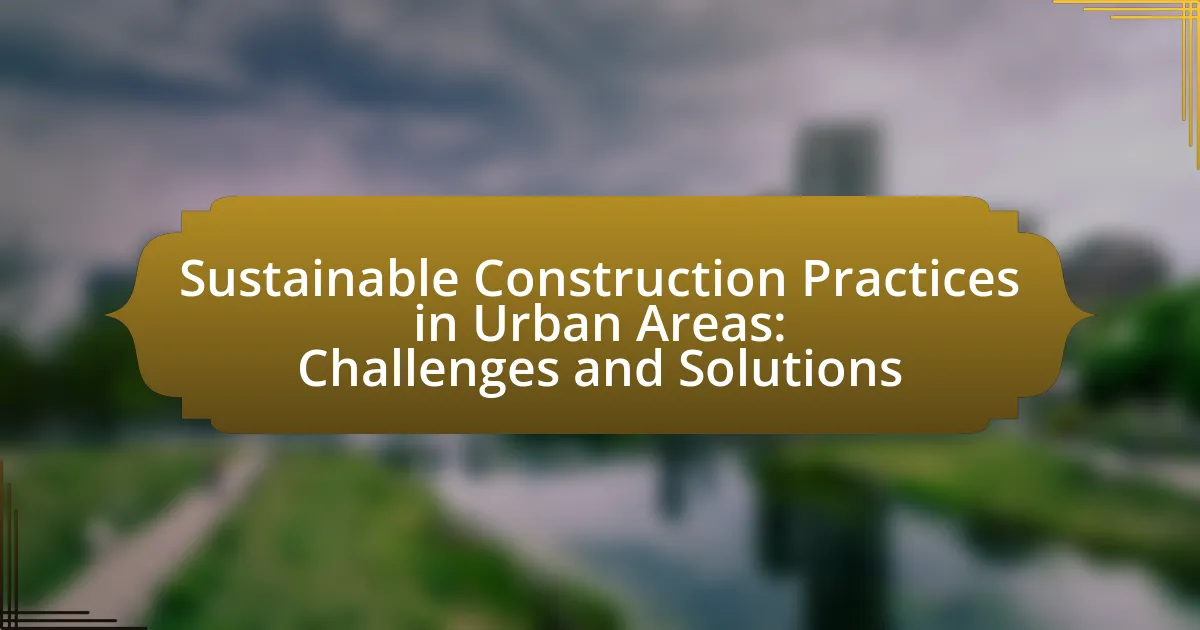Sustainable construction practices in urban areas focus on minimizing environmental impact while enhancing social and economic benefits. This article examines the importance of these practices, highlighting strategies such as the use of eco-friendly materials, energy-efficient designs, and waste reduction techniques. It also addresses the challenges urban areas face in implementing sustainable construction, including financial barriers and regulatory complexities. Furthermore, the article explores innovative solutions and technologies that can support sustainable initiatives, as well as future trends influenced by climate change and emerging technologies. Key performance indicators for measuring sustainability in construction are also discussed, providing a comprehensive overview of the current landscape and future directions in sustainable urban construction.

What are Sustainable Construction Practices in Urban Areas?
Sustainable construction practices in urban areas include strategies that minimize environmental impact while promoting social and economic benefits. These practices encompass the use of eco-friendly materials, energy-efficient designs, waste reduction techniques, and sustainable water management systems. For instance, the integration of renewable energy sources, such as solar panels, in building designs can significantly reduce carbon footprints. Additionally, implementing green roofs and walls can enhance biodiversity and improve air quality. According to the U.S. Green Building Council, buildings that adhere to sustainable practices can reduce energy consumption by up to 30% and water usage by 20-50%. These statistics underscore the effectiveness of sustainable construction in urban settings.
Why are Sustainable Construction Practices important in urban settings?
Sustainable construction practices are important in urban settings because they significantly reduce environmental impact while promoting resource efficiency. Urban areas face challenges such as high population density and limited resources, making sustainable practices essential for minimizing waste, lowering carbon emissions, and conserving energy. For instance, buildings constructed with sustainable materials can reduce energy consumption by up to 30%, as reported by the U.S. Green Building Council. Additionally, these practices enhance the quality of life by improving air quality and creating green spaces, which are vital for urban health and well-being.
What environmental impacts do traditional construction methods have?
Traditional construction methods have significant environmental impacts, primarily through resource depletion, waste generation, and greenhouse gas emissions. These methods often rely on non-renewable materials such as concrete and steel, which contribute to habitat destruction and increased carbon footprints during extraction and production. For instance, the cement industry alone accounts for approximately 8% of global carbon dioxide emissions, highlighting the substantial environmental toll of traditional practices. Additionally, construction activities generate large amounts of waste, with estimates suggesting that construction and demolition waste constitutes about 30% of total waste in urban areas. This waste often ends up in landfills, further exacerbating environmental degradation.
How do sustainable practices mitigate these impacts?
Sustainable practices mitigate environmental impacts by reducing resource consumption and minimizing waste generation. For instance, the use of energy-efficient materials and technologies in construction lowers greenhouse gas emissions, contributing to climate change mitigation. According to the U.S. Green Building Council, buildings that adhere to sustainable practices can reduce energy use by up to 30% compared to conventional buildings. Additionally, implementing water conservation techniques, such as rainwater harvesting and greywater recycling, decreases water usage and protects local water resources. These practices collectively enhance urban resilience and promote a healthier environment.
What are the key principles of Sustainable Construction?
The key principles of Sustainable Construction include resource efficiency, environmental protection, and social responsibility. Resource efficiency emphasizes minimizing material use and energy consumption throughout the construction process, which can be achieved through techniques such as using recycled materials and optimizing design for energy performance. Environmental protection focuses on reducing the ecological footprint of construction activities, including managing waste, protecting biodiversity, and minimizing pollution. Social responsibility involves ensuring that construction practices benefit communities, promote health and safety, and provide equitable access to resources. These principles are supported by various studies, such as the “Sustainable Construction: A Guide to the Principles and Practices” by the World Green Building Council, which highlights the importance of integrating sustainability into all phases of construction to achieve long-term benefits for society and the environment.
What role does energy efficiency play in sustainable construction?
Energy efficiency is crucial in sustainable construction as it significantly reduces energy consumption and greenhouse gas emissions. By implementing energy-efficient designs and technologies, buildings can minimize their reliance on non-renewable energy sources, leading to lower operational costs and a reduced environmental footprint. For instance, according to the U.S. Department of Energy, energy-efficient buildings can use 30% to 50% less energy than conventional buildings, demonstrating the substantial impact of energy efficiency on sustainability in construction.
How does material selection contribute to sustainability?
Material selection significantly contributes to sustainability by influencing resource efficiency, energy consumption, and waste generation in construction. Sustainable materials, such as recycled steel or bamboo, reduce the need for virgin resources and lower the carbon footprint associated with extraction and processing. For instance, using recycled materials can decrease energy use by up to 95% compared to traditional materials, as reported by the U.S. Environmental Protection Agency. Additionally, selecting materials with lower environmental impacts, such as those that are locally sourced, minimizes transportation emissions and supports local economies. Therefore, thoughtful material selection is essential for enhancing the sustainability of construction practices in urban areas.
What challenges do urban areas face in implementing Sustainable Construction Practices?
Urban areas face significant challenges in implementing Sustainable Construction Practices, primarily due to high population density, limited space, and regulatory complexities. High population density leads to increased demand for housing and infrastructure, often prioritizing speed and cost over sustainability. Limited space restricts the ability to incorporate green building techniques and materials, making it difficult to achieve energy efficiency and reduce waste. Additionally, regulatory complexities, including zoning laws and building codes, can hinder the adoption of innovative sustainable practices. These factors collectively create barriers that urban areas must navigate to successfully implement sustainable construction initiatives.
What are the financial barriers to sustainable construction?
The financial barriers to sustainable construction include high upfront costs, limited access to financing, and perceived risks associated with new technologies. High upfront costs often deter developers from investing in sustainable materials and practices, as these can be significantly more expensive than conventional options. Limited access to financing arises because traditional lenders may be unfamiliar with sustainable construction practices, leading to a lack of funding opportunities. Additionally, perceived risks, such as uncertain returns on investment and potential market fluctuations, further discourage investment in sustainable projects. According to a report by the World Green Building Council, these financial barriers can hinder the adoption of sustainable construction practices, ultimately impacting the overall growth of green building initiatives.
How do regulatory frameworks affect sustainable practices?
Regulatory frameworks significantly influence sustainable practices by establishing guidelines and standards that promote environmental protection and resource efficiency. These frameworks, such as building codes and environmental regulations, compel construction projects to adhere to sustainability principles, thereby reducing carbon footprints and enhancing energy efficiency. For instance, the implementation of the International Energy Conservation Code (IECC) has led to a measurable decrease in energy consumption in buildings, demonstrating the effectiveness of regulatory measures in fostering sustainable construction practices.

What solutions exist to overcome challenges in Sustainable Construction?
Solutions to overcome challenges in Sustainable Construction include the adoption of advanced building materials, implementation of energy-efficient technologies, and integration of sustainable design principles. Advanced building materials, such as recycled steel and low-carbon concrete, reduce environmental impact and enhance durability. Energy-efficient technologies, like solar panels and smart HVAC systems, significantly lower energy consumption and operational costs. Sustainable design principles, including passive solar design and green roofs, optimize resource use and improve occupant comfort. These solutions are supported by studies indicating that sustainable construction practices can reduce greenhouse gas emissions by up to 30% and improve overall building performance.
How can technology enhance sustainable construction practices?
Technology can enhance sustainable construction practices by optimizing resource use, improving energy efficiency, and facilitating waste reduction. For instance, Building Information Modeling (BIM) allows for precise planning and resource management, which can reduce material waste by up to 30% during construction. Additionally, smart building technologies, such as energy management systems, can significantly lower energy consumption by monitoring and adjusting usage in real-time, leading to reductions in carbon emissions. Furthermore, advancements in materials science, such as the development of recycled and eco-friendly materials, contribute to sustainability by minimizing the environmental impact of construction activities. These technological innovations collectively support the goal of sustainable construction by promoting efficiency and reducing the ecological footprint of urban development.
What innovative materials are being used in sustainable construction?
Innovative materials used in sustainable construction include cross-laminated timber (CLT), recycled steel, and hempcrete. Cross-laminated timber is a sustainable alternative to concrete and steel, offering a lower carbon footprint and excellent structural performance. Recycled steel reduces the need for new raw materials and minimizes waste, as it can be repurposed from old buildings. Hempcrete, made from hemp fibers and lime, provides insulation and is carbon-negative, sequestering more carbon dioxide than is emitted during its production. These materials contribute to reducing environmental impact while enhancing the efficiency and sustainability of construction practices.
How does building information modeling (BIM) support sustainability?
Building Information Modeling (BIM) supports sustainability by enabling efficient resource management and reducing waste throughout the construction process. BIM facilitates precise planning and visualization, allowing stakeholders to analyze energy consumption, material usage, and environmental impacts before construction begins. For instance, studies show that projects utilizing BIM can reduce material waste by up to 30% and energy consumption by 20% during the operational phase. This data underscores BIM’s role in promoting sustainable practices in urban construction by optimizing design and operational efficiency.
What role do community engagement and education play in promoting sustainability?
Community engagement and education are crucial in promoting sustainability by fostering awareness, participation, and informed decision-making among individuals and groups. Engaged communities are more likely to adopt sustainable practices, as education equips them with the knowledge needed to understand the environmental impacts of their actions. For instance, studies show that communities involved in sustainability initiatives, such as local recycling programs or energy conservation efforts, demonstrate higher rates of participation and success. Research conducted by the National Academy of Sciences indicates that educational programs can lead to a 20-30% increase in sustainable behaviors among participants. This evidence underscores the importance of community engagement and education as foundational elements in driving sustainable practices in urban areas.
How can public awareness campaigns influence construction practices?
Public awareness campaigns can significantly influence construction practices by promoting sustainable methods and encouraging compliance with environmental regulations. These campaigns educate stakeholders, including builders, architects, and the general public, about the benefits of sustainable construction, such as reduced carbon footprints and improved energy efficiency. For instance, a study by the World Green Building Council found that increased public awareness leads to a 20% rise in the adoption of green building practices among construction firms. By highlighting successful case studies and providing resources, these campaigns can shift industry norms and consumer expectations, ultimately driving the construction sector towards more sustainable practices.
What partnerships can be formed to support sustainable initiatives?
Partnerships that can be formed to support sustainable initiatives include collaborations between government agencies, non-profit organizations, private sector companies, and academic institutions. These partnerships can leverage resources, expertise, and funding to implement sustainable construction practices effectively. For example, the U.S. Green Building Council collaborates with various stakeholders to promote sustainable building standards, demonstrating the effectiveness of multi-sector partnerships in advancing sustainability goals. Additionally, public-private partnerships can facilitate the development of green infrastructure projects, such as renewable energy installations and sustainable urban planning initiatives, thereby enhancing community resilience and environmental stewardship.

What are the future trends in Sustainable Construction Practices in Urban Areas?
Future trends in sustainable construction practices in urban areas include the increased use of green building materials, the integration of smart technologies, and the adoption of circular economy principles. Green building materials, such as recycled steel and low-VOC paints, are gaining popularity due to their reduced environmental impact and improved indoor air quality. Smart technologies, including energy management systems and IoT devices, enhance energy efficiency and resource management in buildings. Additionally, circular economy principles promote the reuse and recycling of materials, minimizing waste and reducing the demand for new resources. According to the World Green Building Council, buildings that incorporate these practices can reduce energy consumption by up to 50%, demonstrating the effectiveness of these trends in promoting sustainability in urban construction.
How is climate change influencing sustainable construction strategies?
Climate change is significantly influencing sustainable construction strategies by necessitating the adoption of resilient building practices that minimize environmental impact. As extreme weather events become more frequent due to climate change, construction strategies are increasingly focused on using sustainable materials, improving energy efficiency, and enhancing the durability of structures. For instance, the Global Status Report for Buildings and Construction 2020 indicates that buildings account for 39% of global carbon emissions, prompting the industry to prioritize low-carbon technologies and renewable energy sources in new developments. This shift not only addresses the urgent need to reduce greenhouse gas emissions but also aligns with regulatory frameworks aimed at mitigating climate change effects, such as the Paris Agreement.
What are the emerging technologies shaping the future of construction?
Emerging technologies shaping the future of construction include Building Information Modeling (BIM), 3D printing, drones, and modular construction. BIM enhances collaboration and efficiency by allowing stakeholders to visualize and manage building projects in a digital environment, leading to reduced errors and costs. 3D printing enables the rapid production of building components, which can significantly decrease material waste and construction time. Drones are utilized for site surveying and monitoring, providing real-time data that improves project management and safety. Modular construction allows for off-site fabrication of building sections, which can be assembled on-site, reducing construction time and minimizing environmental impact. These technologies collectively contribute to more sustainable construction practices by optimizing resource use and reducing waste.
What best practices can be adopted for successful sustainable construction?
Successful sustainable construction can be achieved by adopting best practices such as utilizing renewable materials, implementing energy-efficient designs, and ensuring effective waste management. Utilizing renewable materials, like bamboo and recycled steel, reduces environmental impact and promotes resource conservation. Energy-efficient designs, which include passive solar heating and high-performance insulation, can decrease energy consumption by up to 30%, as reported by the U.S. Department of Energy. Effective waste management practices, such as recycling construction debris and minimizing waste generation, can divert up to 90% of waste from landfills, according to the Environmental Protection Agency. These practices collectively contribute to reducing the carbon footprint and enhancing the sustainability of construction projects.
How can project managers ensure compliance with sustainability standards?
Project managers can ensure compliance with sustainability standards by integrating sustainability criteria into project planning and execution. This involves conducting thorough assessments of environmental impacts, adhering to local and international sustainability regulations, and implementing best practices in resource management. For instance, the Leadership in Energy and Environmental Design (LEED) certification provides a framework that project managers can follow to meet sustainability benchmarks. Additionally, regular training and updates on sustainability standards for the project team can enhance compliance, as evidenced by studies showing that informed teams are more likely to implement sustainable practices effectively.
What are the key performance indicators for measuring sustainability in construction?
Key performance indicators (KPIs) for measuring sustainability in construction include energy efficiency, water usage, waste management, and carbon footprint. Energy efficiency is assessed through metrics like energy consumption per square meter, while water usage is measured by the volume of water used in construction processes. Waste management is evaluated by the percentage of materials recycled or diverted from landfills, and the carbon footprint is quantified by the total greenhouse gas emissions produced during construction activities. These KPIs provide a comprehensive framework for assessing the sustainability of construction projects, enabling stakeholders to make informed decisions that align with environmental goals.

Leave a Reply